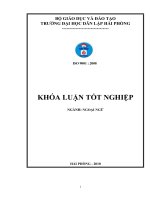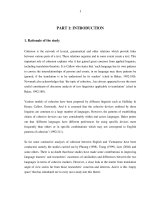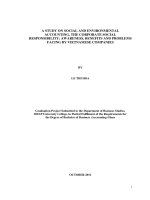Study on methanotrophs and their some potential application aspects nghiên cứu vi khuẩn ôxi hóa metan và tiềm năng ứng dụng sinh học
Bạn đang xem bản rút gọn của tài liệu. Xem và tải ngay bản đầy đủ của tài liệu tại đây (13.41 MB, 82 trang )
LIEGE UNIVERSITY
---***---
VIETNAM NATIONAL UNIVERSITY, HANOI
Institute of Microbiology and Biotechnology
-----***-----
Nguyen Thi Hieu Thu
STUDY ON METHANOTROPHS AND THEIR SOME
POTENTIAL APPLICATION ASPECTS
Specialty: Biotechnology
Code: 60 42 02 01
MASTER THESIS
SUPERVISOR: Dr. DINH THUY HANG
Hanoi, 2014
1
ACKNOWLEDGEMENTS
Foremost, I would like to express my deep gratitude to my advisor Dr. Dinh
Thuy Hang for her patience, motivation, enthusiasm, and immense knowledge. Her
guidance helped me in all the time of research and writing of this thesis.
I am indebted to all the lecturers of Vietnam National University, Hanoi
(Vietnam) and University of Liege (Belgium) for sharing their valuable scientific
knowledge.
I thank my lab mates in Microbial Ecology Department (Institute of
Microbiology and Biotechnology) for the stimulating discussions, for providing
guidance, and for all the fun we have had.
Finally, and most importantly, I would like to thank my family, especial my
husband, for unconditional supports that made this thesis possible.
Hanoi, December 2013
Nguyen Thi Hieu Thu
2
TABLE OF CONTENTS
Acknowledgements .................................................................................................... 1
Table of contents ........................................................................................................ 2
List of figures ............................................................................................................. 4
List of tables ............................................................................................................... 6
Abbreviations ............................................................................................................. 7
Abstract ...................................................................................................................... 8
Tóm tắt ....................................................................................................................... 9
Preface ........................................................................................................................ 10
Chapter 1. Introduction ........................................................................................... 11
1.1. Methane and global climate change ......................................................... 11
1.2. Methanotrophs .......................................................................................... 12
1.2.1. Phylogeny of methanotrophs ...................................................... 12
1.2.2. Physical diversity of methanotrophs .......................................... 15
1.3. Aerobic methane oxidation ...................................................................... 17
1.4. Methane monooxygenase ......................................................................... 20
1.4.1. The role of MMOs in MOB ....................................................... 20
1.4.2. Soluble methane monooxygenase .............................................. 21
1.4.3. Particulate methane monooxygenase ......................................... 23
1.5. Application potential of Methanotrophs................................................... 25
1.5.1. Food for animal .......................................................................... 25
1.5.2. Bioconversion of methane to methanol ...................................... 27
1.5.3. Environmental bioengineering ................................................... 29
1.6. Objectives of this study ............................................................................ 35
Chapter 2. Material and Methods........................................................................... 36
2.1. Sampling................................................................................................... 36
2.2. Isolation of methanotrophs....................................................................... 36
2.3. DNA extraction and PCR amplification .................................................. 38
2.4. DGGE....................................................................................................... 40
2.5. Sequencing and phylogenetic analysis ..................................................... 41
2.6. Morphological and physiological characterization .................................. 41
3
2.7. Chemical analyses .................................................................................... 42
Chapter 3. Results and discussion........................................................................... 43
3.1. Enrichment and isolation of MOBs from environmental samples ........... 43
3.1.1. Enrichment of MOBs ................................................................ 43
3.1.2. Isolation of MOBs and preliminary identification .................... 44
3.2. Study the presence of MMO encoding genes in the isolates .................... 46
3.3. Growth of the MOB isolates with methane .............................................. 48
3.4. Morphology, physiology and phylogeny of strain BG3 ........................... 49
3.5. Application experiments using Methylomonas sp. BG3 as model
organism ................................................................................................... 52
3.5.1. Study on bacterial meal production ............................................ 52
3.5.2. Study on reduction of methane emission from organic wastes..55
Conclusion and Prospective works ......................................................................... 58
References .................................................................................................................. 59
Appendix .................................................................................................................... 74
4
LIST OF FIGURES
Figure
Title
Figure 1.1.
Phylogenetic relationships between known methanotrophs based
on 16S rRNA gene sequences using MEGA4…………………...
15
Pathways for the oxidation of methane and assimilation of
formaldehyde in MOBs………………………………………….
18
RuMP pathway for HCHO assimilation in Type I
methanotrophs……………………………………………………
19
Serine pathway for the assimilation of formaldehyde in Type II
methanotrophs……………………………………………………
19
Figure 1.5.
Orientation of soluble mono-oxygenase gene cluster……………
22
Figure 1.6.
The crystal structure of hydroxylase dimer……………………...
22
Figure 1.7.
Particulate methane monooxygenase gene clusters of methaneoxidizingbacteria…………………………………………………
23
Figure 1.8.
Crystal structure of a single promoter of pMMO………………..
24
Figure 1.9.
The schematic bench scale plant for treatment of diluted landfill
gas in biofilters…………………………………………………..
30
Figure 1.2.
Figure 1.3.
Figure 1.4.
Figure 1.10.
The schematic biofilter. …………………………………………
Figure 1.11.
Horizontal injection and extraction of methane, air, and nutrient
used in in-situ bioremediation of TCE. …………………………
Figure 3.1.
Page
31
33
Methane consumption in enriched cultures of MOBs after 7
days of cultivation. ……………………………………………...
43
The increase in culture turbidity through three steps of
enrichment of sample PS. ……………………………………….
44
Isolation of MOB via liquid dilution series in the wells of 96well plates. ………………………………………………………
45
Figure 3.4.
DGGE analysis of PCR-amplified 16S rDNA fragments of the
isolates obtained from the MOB-enrichment cultures. ………….
46
Figure 3.5.
PCR products of pmoA gene fragments (508 bp). ………………
47
Figure 3.2.
Figure 3.3.
5
Figure 3.6.
Agarose gel electrophoresis of the mmoX gene PCR products
yielded from genome of the isolates (800 bp). ………………….
48
Figure 3.7.
Growth of the MOB isolates with methane as shown by optical
density of the liquid cultures after 4 days cultivation. ………….
49
Figure 3.8.
Phase – contrast micrographs of the MOB isolates grown in
liquid cultures with methane (viewed at 1000× magnifications).
49
Figure 3.9.
Phylogenetic tree based on the 16S rRNA gene sequences
showing the relationship of strains BG3 and other known
methanotrophs. ………………………………………………….
50
Figure 3.10.
Phylogenetic analysis of partial amino acid sequences encoded
by the pmoA gene from the three MOB isolates. ……………….
51
Figure 3.11.
Cultivation condition-dependent growth of strain BG3. ………..
Figure 3.12.
Cultivation of BG3 with methane. ………………………………
52
Figure 3.13.
Experimental generation of methane from organic wastes. …….
Figure 3.14.
Control of methane emission from organic wastes in laboratory
model using strain BG3. ………………………………………..
55
6
53
56
LIST OF TABLES
Table
Title
Page
Table 1.1. Characteristics of methanotrophs. ........................................................... 14
Table 1.2. Chemical and amino acid composition of BPM, fishmeal and soybean
meal (SBM). ............................................................................................. 26
Table 2.1. Fresh water mineral medium. .................................................................. 36
Table 2.2. Metal mix and vitamin mix. .................................................................... 36
Table 3.1. Bacterial strains isolated from MOB-enrichment samples by using
liquid serial dilution method. ................................................................... 45
Table 3.2. Crude protein content in biomass of MOB and other bacterial species. ... 54
7
ABBREVIATIONS
16S rDNA
Gene coding for small subunit of ribosomal deoxyribonucleic acid
Bp
Base pair
BSA
Bovin serum albumin
CI
Chloroform-isoamyl alcohol
DGGE
Denaturing gradient gel electrophoresis
DNA
Deoxyribonucleic acid
dNTP
Deoxyribonucleotide triphosphate
EDTA
Ethylenediaminetetraacetic acid
EPS
Extracellular/exo- polymeric substance
ICM
Intracytoplasmic membrane
MOB
Methane oxidizing bacteria
MQ
Mili-Q
OD
Optical density
PCR
Polymerase chain reaction
pMMO
Particulate methane mono-oxygenase
pmoA
Gene for alpha subunit of the pMMO
SDS
Sodium dodecyl sulfate
sMMO
Soluble methane mono-oxygenase
TAE
Tris-Acetic-EDTA
Taq
Thermus aquaticus DNA polymerase
BPM
Bacterial protein meal
8
ABSTRACT
From environmental samples of different locations, three freshwater strains of
methane oxidizing bacteria (MOBs), i.e. BG3, PS1 and W1, were isolated by using
serial dilution method in liquid mineral medium with methane as the only carbon and
energy sources. These three isolates contained genes encoding for the particulate
methane-mono-oxygenase (pMMO) but not the soluble one (sMMO), indicating that
they would not be expected to growth on a broad range of organic substrates.
Of the three isolates, strain BG3 showed the highest growth with methane and
thus was selected and used as model organisms in further experiments on application
aspects. Optimal cultivation conditions for this strain were also determined, i.e. pH 68, temperature 25-40 oC, salinity of 1-15 g. L-1 NaCl. Based on phylogenetic analyses
of the 16S rDNA partial gene sequences, strain BG3 was identified as a member of the
Methylomonas genus (type I methanotroph), the most closely related species was
Methylomonas methanica (95% homology). This strain was designated with the name
Methylomonas sp. BG3 and its 16S rDNA partial sequence was deposited at the
GenBank under accession number of KJ081955. In addition, pmoA gene has also been
detected in this strain and a gene sequence fragment (508 bp) was deposited the
GenBank under accession number of KJ081956.
Studies on the application aspects of MOBs were conducted with the use of
strain BG3 as the model organism. It has been shown that methane-fed culture of strain
BG3 could yield 1.26 g⋅l 1 cell dry weight (CDW), accordingly produce 68.69 g crude
−
protein per 100 g CDW and the efficiency of methane consumption in this respect was
2.85 m3 per kg CDW. In the study on control of methane emission by MOB, strain
BG3 showed the capability of reducing 77.46 % of total volume of methane emitted
from anaerobically decomposing organic wastes.
Key words: methanotroph, Methylomonas, pmoA, biomass production, methane
emission
9
TĨM TẮT
Từ các mẫu mơi trường thu thập từ các địa điểm khác nhau, ba chủng vi khuẩn
oxy hóa metan gồm BG3, PS1 và W1 đã được phân lập nhờ phương pháp pha lỗng
trong mơi trường khống dịch thể sử dụng metan làm nguồn cacbon và năng lượng duy
nhất. Ba chủng nói trên chứa gen mã hóa cho enzyme methane monooxygenase ở dạng
hạt nhưng không chứa gen mã hóa cho enzyme này ở dạng hịa tan, chứng tỏ ba chủng
này khơng có khả năng sinh trưởng trên đa dạng các loại cơ chất hữu cơ khác nhau.
Trong ba chủng phân lập được, chủng BG3 có khả năng sinh trưởng tốt nhất
trong điều kiện có metan do đó chủng này được lựa chọn và sử dụng như vi sinh vật
mơ hình trong các thí nghiệm tiếp theo về tiềm năng ứng dụng. Các điều kiện nuôi cấy
tối ưu của chủng này đã được xác định bao gồm: pH 6-8, nhiệt độ 25-40oC, nồng độ
muối 1-15g⋅L-1 NaCl. Dựa trên các phân tích trình tự đoạn gen 16S rDNA, chủng BG3
được xác định là một thành viên của chi Methylomonas (vi khuẩn sử dụng metan tuýp
I) với chủng gần gũi nhất là Methylomonas methanica (độ tương đồng 95%). Chủng
này được đặt tên là Methylomonas sp. BG3 và trình tự đoạn gen 16S rDNA của nó đã
được gửi vào ngân hàng gen dưới mã số KJ081955. Ngoài ra, gen pmoA cũng đã được
xác định có mặt ở chủng này với đoạn gen dài 508 bp được gửi tại GenBank với mã số
KJ081956.
Một số hướng ứng dụng của vi khuẩn oxy hóa metan đã được tiến hành nghiên
cứu với vi sinh vật mơ hình là chủng BG3. Ni cấy chủng BG3 với metan tạo sinh
khối có trọng lượng khơ tế bào là 1,26 g/l, hàm lượng protein thô là 69,69g/100 g
CDW và hiệu suất sử dụng metan là 2,85 m3 metan/kg CDW. Trong điều kiện thí
nghiệm chủng BG3 có khả năng loại bỏ 77,46 % thể tích metan sinh ra trong quá trình
phân hủy kỵ khí rác hữu cơ.
Từ khóa: vi khuẩn oxy hóa metan, Methylomonas, pmoA, tạo sinh khối, phát thải
metan.
10
PREFACE
Since the late 19th century, global warming has been detected with the rise in the
average temperature of Earth's atmosphere and oceans. During this 21st century, the
global surface temperature is predicted to rise a further 1.1 to 6.4 °C (IPPC 2007).
Today, climate change shows multi-aspect impacts to the life on earth, e.g. sea levels
rising, precipitation changing, subtropical desert expansion etc., and subsequently
affects to food security of humans due to decreasing crop yield and the loss of habitat
from inundation.
The primary reason causing the climate change is the increasing emission of
greenhouse gases, including water vapor, carbon dioxide, methane, nitrous oxide and
ozone (Karl et al., 2003). Next to carbon dioxide (the most effective greenhouse gas
with fast increasing concentration in the atmosphere, reaching 392.6 ppm in 2012 Trends in Atmospheric Carbon Dioxide, 2012), methane is considered to be the
second most important greenhouse gas, the level of which in the atmosphere increased
drastically, mainly due to the extensive exploration of anthropogenic sources.
In nature, methane-oxidizing bacteria (MOBs) represent a unique microbial
group involving in the methane cycling. These microorganisms can utilize methane as
a growth substrate, and thus participate in the control of methane emission as well as
many other applications. In Vietnam, organic pollution is of great concern, and
methane released from organic wastes has not been effectively used. From scientific
viewpoint, methane-oxidizing bacteria have not been looked at and considered as a
tool for resolving these problems.
In the present work, for the first time methanotrophs have been enriched and
isolated from environmental samples and primary studies on their application were
carried out.
11
Chapter 1. INTRODUCTION
1.1. Methane and global climate change
Methane is a colorless and odorless gas that makes the major component (97% vol.) of
natural gas. Methane has a strong absorbance of infrared radiation, which is not able to
escape from the Earth’s atmosphere, leading to the global warming (Lelieveld et al.,
1993). Although carbon dioxide is the single largest greenhouse gas in terms of global
warming potential, methane is the most significant contributor to the greenhouse effect
after CO2, and on a molar basis it is about 23 times more effective than CO2 (IPCC,
2007).
Global population increases and the consequent rise in consumption of fossil
energy as well as the generation of waste have led to a large increase of the
anthropogenic methane emission, which now accounts for ~ 70% of 5200 ton CH4
emitted each year to the atmosphere (Breas et al., 2001; IPCC, 1996). The major
natural sources of methane include natural wetlands, paddy fields, ruminants, lakes
and oceans. Fossil fuel exploitation, livestock feeding operations, landfills and rice
cultivation have been counted as the largest anthropogenic sources, that have been
rising dramatically since the beginning of the industrial era. Consequently, the
atmospheric methane concentration has increased from 0.75 – 1.75 ppm in the last 300
years at an enormous rate might reach 4.0 ppm till 2050 (Ramanathan et al., 1985).
Unfortunately, the control of methane emission has not yet received appropriate
attention, and in the last decade there were little changes in the atmospheric methane.
This will be a serious problem for climate change that has become a global concern
and more attention needs to be paid to this field of research.
12
1.2. Methanotrophs
Methanotrophs (MOBs) are a unique group of methylotrophic bacteria with the ability
to utilize methane as their sole carbon and energy source (Hanson & Hanson 1996,
Murrel 1994). Methylotrophs are phylogenetically widespread, including archaea,
eubacteria and yeasts that are capable of utilizing a wide variety of C-1 compounds
such as methane, methanol, methylamines, etc. Whereas known MOBs belong only to
the α and γ-subclass of Proteobacteria and are unique as they grow mainly on
methane, sometimes also methanol, as their sole carbon and energy source with
oxygen as the terminal electron acceptor (Hanson & Hanson, 1996). Almost all MOBs
are obligatory methylotrophic and cannot utilize complex C compounds such as sugars
and organic acids (Bowman, 2000). However, facultative methanotrophic strains have
been detected recently. This could be due to the lack of certain enzymes in the Krebs
cycle like α-ketogulatarate dehydrogenase or the lack of specific transporter for
complex C compounds in these organisms (Dedysh et al., 2005).
The first bacterium growing on methane was isolated from pond water and
aquatic plants in 1906 by the Dutch microbiologist Nicolaas Sohngen. Till 1970s,
more than 100 MOB strains were isolated, establishing a new era of research on
biochemical properties and pathways of aerobic methane oxidation. To date, these
organisms have been found in a wide variety of environments including soils
(Whittenbury et al., 1970), sediments (Smith et al., 1997), landfill (Wise et al., 1999),
groundwater (Fliermans et al., 1988), seawater (Holmes et al., 1995), peatbog (Dedysh
et al., 2000; Mcdonald et al., 1996) etc., showing their ubiquitous involvement in the
methane cycling.
1.2.1. Phylogeny of methanotrophs
Based on morphology and many other physiological properties (table 1.1) such as the
arrangement of intra-cytoplasmic membranes, pathways of carbon assimilation,
13
nitrogen fixation ability, the presence of cysts or spores, colony color and motility, the
methanotrophs were initially classified into five genera Methylosinus, Methylocystis,
Methylomonas, Methylobacter and Methylococcus (Whittenbury et al., 1970). Latter,
with the development of molecular tools in microbial taxonomy, these organisms have
been reorganized into two families Methylococcaceae (comprising Type I- and Type
X-methanotrophs) and Methylocystaceae (Type II methanotrophs).
methanotrophs
contains
Methylomicrobium,
nine
genera
Methylosphaera,
Methylomonas,
Methylosarcina,
The type IMethylobacter,
Methylothermus,
Methylohalobium, Methylosoma and Methylovulum. Two genera Methylocaldum and
Methylococcus are grouped in Type X as they are phylogenetically and
morphologically distinct from the other Type I genera. Whereas, Type IImethanotrophs consist of five genera Methylosinus, Methylocystis, Methylocella,
Methylocapsa and Methyloferula (Bowman et al., 1993, 1995; Bussmann et al., 2006;
Heyer et al., 2005; Rahalkar et al., 2007; Iguchi et al., 2011; Dedysh et al., 2011). The
major distinction between types I and II-methanotrophs is the pathway of
incorporating formaldehyde into cell biomass. Type I-methanotrophs assimilate
formaldehyde via ribulose monophosphate (RuMP) pathway, while type II
methanotrophs use serine pathway for the same operation (Fig. 1.3, 1.4).
However, it seems that the present classification system as shown in table 1.1
has not yet been covering all MOB species. Recently, a filamentous MOB Clorothrix
fusca and three extremely acidophilic bacteria of the phylum Verrrucomicrobia have
been isolated and characterized as members of the genus Methylacidiphylum, which
does not belong to either α or γ-Proteobacteria. These bacteria have been found to
have striking dissimilarities to other known MOB (Stoecker et al, 2006; Dunfield et
al., 2007; Hou et al., 2008; Vigliotta et al., 2007) (Fig. 1.1).
14
Table 1.1. Characteristics of methanotrophs (Hanson & Hanson, 1996)
Characteristics
Methanotrophs
Type I
Family
Type X
Methylococcaceae
Type II
Methylocystaceae
Member genera
Methylosphaera
Methylobacter
Methylomicrobium
Methylomonas
etc.
Methylococcus
Methylocaldum
Methylosinus
Methylocystis
Methylocella
Methylocapsa
Methyloferula
Cell morphology
Short rods, some
coccid or
ellipsoids
Coccid, often
found as pairs
Crescent-shape rods,
rods, pear-shape
cells, rosette
(sometimes)
Resting stages
Azotobacter-type
cysts (or none)
Azotobactertype cysts
Exosprores or
lipoidal cysts
Yes
Yes
No
No
No
Yes
Nitrogen fixation
No
Yes
Yes
Carbon assimilation
pathway
RuMP
RuMP
Serine
Major fatty acid carbon
chain length
16
16
18
Mol% G+C (Tm)
43-60
56-65
60-67
Phylogenetic group
(Proteobacteria)
Gamma
Gamma
Alpha
Membrane arrangement:
- Bundles of vesicular
disks
- Paired membranes
aligned to periphery of
cells
15
Figure 1.1.
Phylogenetic relationships between known methanotrophs based on 16S rRNA
gene sequences using MEGA4 (Tamura et al., 2007). The tree was constructed using the
neighbor-joining method with 1304 positions of 16S rRNA genes
1.2.2. Physiological diversity of methanotrophs
Methanotrophs are widespread in nature, almost all samples taken from muds,
swamps, rivers, rice paddies, oceans, deciduous woods, sewage pludge, sediments…
contained MOBs. Most cultured methanotrophs are mesophilic and neutrophilic,
favoring moderate temperature (~25oC) and pH (pH 6-7) conditions (Hanson &
Hanson, 1996). However, investigation of the extreme environments with high and
low pH, temperature or salinities have led to the discovery of a variety of
extremophilic and extreme-tolerant methanotrophs (Murell et al., 1998; Trotsenko,
Khmelenina, 2002).
Methylococcus capsulatus, the earliest described heat-tolerant methanotroph,
grows at temperature up to 50 oC (Foster & Davis, 1966; Whittenbury et al., 1970).
Several other moderately thermophilic and thermotolerant species, including
16
Methylococcus thermophilus, Methylococcus ucrainicus, Methylocaldum szegediense,
Methylocaldum tepidum and Methylocaldum gracile were subsequently described
(Malashenko et al., 1975, 1976; Bodrossy et al., 1995, 1997, 1999; Eshinimaev et al.,
2004). Very recently, the representatives of a novel group of truly thermophilic
methanotrophs (Methylothermus) were isolated from Hungarian and Japanese hot
springs (Bodrossy et al., 1999; Tsubota et al., 2011), with temperature limits for
growth were 40 - 72 °C and 37 - 67 °C, respectively.
Psychrophilic strains have also been isolated, mostly from Siberian tundra and
antarctic environments (Omelchenko et al., 1993; Bowman et al., 1997; Wartiainen et
al., 2006). These methanotrophs can tolerate temperatures as low as 3.5 °C and usually
have optimum growth temperature between 10 °C and 20 °C.
A variety of acidophilic, alkaliphilic and halophilic methanotrophs have been
observed (Lidstrom et al., 1988; Fuse et al., 1998; Heyer et al., 2005). Recently,
extreme acidophiles that exhibit optimum activity at pH 2.0– 2.5, even below pH1
have been isolated (Dunfield et al., 2007; Pol et al., 2007; Islam et al., 2008). These
bacteria were classified under Verrucomicrobia phylum based on the 16S rDNA
analysis (Figure 1.1). Alkaliphilic methanotrophs have also been isolated with
optimum growth at pH 9.0 and 10.0 (Khmelenina et al., 1997; Sorokin et al., 2000;
Kaluzhnaya et al., 2001; Reshetnikov et al., 2005).
Beside the obligatory methanotrophs, facultative methanotrophic strains that
can utilize a variety of multi-carbon substrates such as ethanol and acetate for growths
were discovered (Dunfield et al., 2003; Dedysh et al., 2005; Dunfield et al., 2010;
Belova et al., 2011; Im et al., 2011; Semrau et al., 2011). A number of characteristics
that are quite unusual for methanotrophs, e.g. the absence of intra-cytoplasmic
membrane, acidophilicity, and tolerance to low temperature were found in
Methylocella silvestris BL2 (Dunfield et al., 2003). More recently, two newly isolated
17
methanotrophs in the α-Proteobacteria, Methylocapsa aurea KYG and Methylocystis
daltona SB2 were found to maintain viability and growth under the presence of acetate
as the sole carbon source (Dunfield et al., 2010; Im et al., 2011). These strains
exhibited higher specific growth rate and both of them constitutively express pMMO
in the presence of acetate without methane.
This great diversity indicates that methanotrophs might be much more diverse
in the natural environments than anticipated from information on isolated laboratory
strains. The abundant resources of methanotrophs also reveal the great potential for
their industrial applications.
1.3. Aerobic methane oxidation
In methanotrophs, methane serves as the energy source (electron donor) and the sole or
partial carbon source as well. In aerobic methane oxidation, the first step is most
difficult and takes place in the intra-cytoplasmic membrane system with the help of
specialized enzymes known as methane mono-oxygenases (MMOs) (Fig.1.2). These
enzymes break the O-O bond in the oxygen molecule by utilizing two reducing
equivalents (Hanson & Hanson, 1996). One of the oxygen atoms is converted to water
and the other is incorporated into methane to form methanol. This reaction requires
additional electrons, which are supply by cellular redox carriers such as cytochrome C
(for particulate, pMMO) or NADH (for soluble MMO).
CH4 + O2 + H++ NADH = H2O + CH3OH + NAD+
Methanol is further oxidized to formaldehyde by methanol dehydrogenase
(MDH). Formaldehyde is the central metabolite in the anabolic and catabolic pathways
of MOBs. In the catabolic pathway, HCHO is further converted to formate and then to
CO2 with the help of a multiple enzyme systems: CH3OH → 2H+ + HCHO → 2H+ +
HCOO-H+ → CO2 + 2H+.
18
Figure 1.2. Pathways for the oxidation of methane and assimilation of formaldehyde in
MOBs (Hanson & Hanson, 1996). Abbreviation: CytC, cytochrome C (red–reduced, oxoxidized); FADH, formaldehyde dehydrogenase; FDH, formate dehydrogenase; MDH,
methanol dehydrogenase.
This process produces most of the reducing power for the metabolism of
methane because in these reactions, electrons are donated back to a component of
membrane–bound electron transport chain, the cytochrome C (MDH) or NAD (in
formaldehyde oxidation system) and FDH. Electron flow through the membrane
ultimately produces a proton motive force that is converted to ATP by ATPase
complex. Oxygen is the terminal electron acceptor (Madigan et al., 2003). HCHO
assimilation takes place via two different pathways in Type I and Type II
methanotrophs. In Type I methanotrophs, it occurs by the ribulose monophosphate
(RuMP) pathway (Fig. 1.3), whereas the Type II methanotrophs use the serine
pathway (Fig. 1.4).
19
Figure 1.3. RuMP pathway for HCHO assimilation in Type I methanotrophs (Hanson &
Hanson 1996).
Figure 1.4. Serine pathway for the assimilation of formaldehyde in Type II methanotrophs
(Hanson & Hanson, 1996). Abbreviation: Serine hydroxyl-methyltransferase (STHM),
hydroxyl pyruvatereductase (HPR), malate thiokinase (MTK), and maleyl coenzyme A lyase
(MCL).
Enzyme systems used for assimilating these C1 units and MMOs as well are
unique to methanotrophs so that they are used as markers to recognize uncultured
species in environmental samples.
20
1.4. Methane mono-oxygenases (MMOs)
1.4.1. The role of MMOs in MOBs
The enzyme methane-monooxygenase (MMO) catalyses the breakdown reaction at the
C–H bonds in methane molecule under ambient conditions despite of its high stability
(Dalton, 2005). Two forms of MMOs, namely membrane-associated or particulate
form (pMMO) and soluble, cytoplasmic form (sMMO) have been found in MOBs.
Although pMMO and sMMO catalyze the same reaction via putatively similar
mechanisms involving metal radicals, they are very different in many aspects, e.g.,
their distribution among methanotrophic strains, activity, and localization in the cell,
structure, and regulation. Kinetic studies on purified sMMO have been carried out for
many years but the exact mechanism of pMMO, the more prevalent form, is still
unknown, largely due to the difficulty in isolation of this enzyme with high activity.
Almost all known methanotrophs possess pMMO except members of the genus
Methylocella which are facultative methylotrophs, able to utilize multi-carbon
substrate (Dedysh et al., 2005). Whereas, the sMMO is present just in a few MOB
species of the genera Methylococcus, Methylomonas, Methylocella, Methylocystis and
Methylosinus (Hanson & Hanson, 1996; McDonald et al., 2006). Many
methanotrophs, such as Methylomicrobium album BG8 possess only the pMMO, but
Methylococcus capsulatus Bath, Methylosinus trichosporium OB3b, and some others
can express either form, depending on the copper concentration in the medium. In
those methanotrophs, there is a metabolic switch mediated by the availability of
copper ions. When cells are starved for copper, and the copper-to-biomass ratio is low,
sMMO is expressed. On the other hand, cells grown under conditions of excess copper
express pMMO and there is no detectable sMMO expression (Murrell et al., 2000). No
evidence of sMMO has been found in acidophilic methanotrophs in the
Verrucomicrobia phylum (Dunfield et al., 2007; Hou et al., 2008; Islam et al., 2008).
21
Crenothrix polyspora that was detected 135 years ago has been discovered to be a
methane oxidizer with an unusual MMO (Stoeker et al, 2006).
Besides the remarkable ability to convert the unreactive methane to methanol,
MMOs can also oxidize other organic substrates even though for these organisms, the
resultant oxidation products cannot be used as nutrient sources.
1.4.2. Soluble methane monooxygenase (sMMO)
sMMO is expressed during growth under low copper–to–biomass conditions and
utilizes NADH and H+ as the electron donor. This enzyme is a complex of three
components (i) non-hemehydroxylase (245 kDa), (ii) a regulatory coupling protein B,
and (iii) a reductase (protein C). The hydroxylase is a dimer of three different subunits
(α, β and γ, of 60, 45 and 20 kDa, respectively) and has a non-heme di-iron active site
in the α-subunit where methanol is formed from methane and oxygen. The reductase
enzyme (protein C) transfers electrons to the hydroxylase for the catalysis of methane
oxidation and the coupling protein (protein B) links two these enzymes. The genes
encoding sMMO have been cloned and sequenced in Methylococcus capsulatus Bath
and Methylosinus trichosporium OB3b. These genes are clustered on the chromosome
in which the α, β and γ subunits of the hydroxylase are coded by mmoXYZ,
respectively; mmoB and mmoC code for protein B and protein C, respectively (Coufal
et al., 2000; Cardy et al., 1991) (Fig.1.5.). Merkx et al. (2002) detected gene orfY
(mmoD) that might play a role in the assembly of the di-iron center of the enzyme in
Methylococcus capsulatus Bath.
22
Figure 1.5. Orientation of soluble mono-oxygenase gene cluster (Murrell et al., 2000).
sMMO has abroad substrate specificity and can co-oxidize a number of other
aromatic compounds and hydrocarbons (Hanson & Hanson, 1996). The substrates of
sMMO include alkanes, alkenes, alicyclic hydrocarbons, halogenated aliphatics, and
aromatic compounds with single oxygenated products generally predominating. Some
small organic compounds that found to be effective substrates for sMMO are
tetrachloromethane, iodomethane, trimethylamine and tetrachloroethene.
Figure 1.6. The crystal structure of hydroxylase dimer with cylinders representing helices and
arrows representing β-strands. α-chains are colored yellow and pink, β-chains are colored
gray and cyan, and γ-chains are colored green (Elango et al., 1997)
23
1.4.3. Particulate methane monooxygenase (pMMO)
pMMO is a membrane – bound enzyme containing copper and iron and is expressed
only when the copper supply in the medium is high (Prior & Dalton, 1985). Like
sMMO, pMMO consists of three subunits including α or pmoA subunit (26 kDa), β or
pmoB subunit (47 kDa) and γ or pmoC subunit (23 kDa), encoded by pmoA, pmoB and
pmoC genes, respectively. There are two nearly identical copies of pmoCAB cluster in
the chromosome of Methylococcus capsulatus Bath, Methylocystis sp. strain M and
M.trichosporium OB3b (Semrau et al., 1995; Stolyar et al., 1999; Gilbert et al., 2000).
Only Methylococcus capsulatus Bath has a third separate copy of pmoC and the
pmoC3 sequence was more divergent from the two others (Stolyar et al., 1999).
Figure 1.7. Particulate methane monooxygenase gene cluster of methane-oxidizing bacteria
(Murrell et al., 2000)
Although numerous efforts have been done in the last 20 years, most of the
information of this predominant methane monooxygenase had remained unanswered
until Lieberman and Rosenzweig (2005) reported the crystal structure of this
membrane protein from M.trichosporium OB3b. The crystal structure of pMMO from
24
this strain was obtained to a resolution of 2.8 Ao. The enzyme is now known to be a
trimer with α3β3γ3 polypeptide arrangement and has three metal centers (Fig. 1.8).
Figure 1.8. Crystal structure of a single promoter of pMMO. PmoA, PmoB, and PmoC are
shown in magenta, yellow, and blue, respectively (Lieberman & Rosenzweig, 2005).
To catalyze reactions pMMO uses a higher – potential electron donor than that
of sMMO, thus methanotrophs that posses pMMO have higher growth yields on
methane and have greater affinity for methane than do methanotrophs that contain
sMMO alone (Hanson & Hanson, 1996). However, pMMO has relatively narrow
substrate specificity and can oxidize only methane, short linear hydrocarbon (up to
five carbons in length) and trichloroethene (DiSpirito et al., 1992).
Comparison of pMMO and ammonia monooxygenase (AMO) gene sequences
suggests that these could be evolutionarily related, as conserved residues are found
throughout the entire length of pmoA and amoA amino acid sequences, implying their
structural similarities (Holmes et al., 1995).
25









